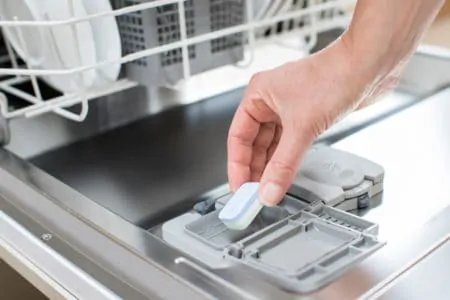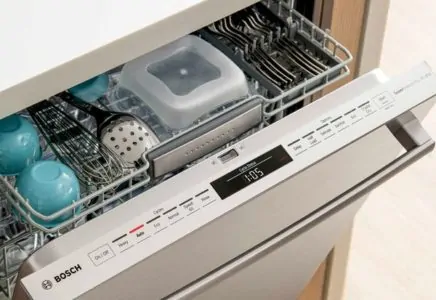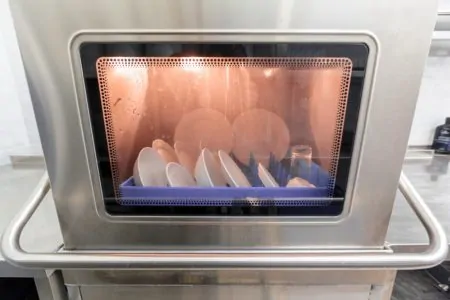There are many different types of dishwasher detergent. You can choose liquid, powder, gel, you can make your own, or you can choose pods!
If you’re curious about dishwasher pods, we’ll walk you through everything there is to know about them. That includes how to use dishwasher pods, how they work and many more frequently asked questions.
Key Takeaways
- Dishwasher pods contain concentrated detergent and dissolve in hot water during the dishwashing cycle.
- Pods are wrapped in a biodegradable, non-toxic film made of polyvinyl alcohol (PVA) that dissolves in water.
- Always place the pod in the detergent dispenser drawer, not directly in the dishwasher, for proper cleaning.
- Rinse aid is recommended if you live in a hard water area to prevent spots and cloudy dishes.
How Do Pods Work in the Dishwasher?
When you place the pod into the detergent dispenser drawer and turn on your appliance, the pod will drop into the bottom of the machine and dissolve in the hot water. Throughout the cycle, the detergent will spread around the dishwasher and clean your dishes.
As for the pod itself, it contains a small amount of concentrated detergent. It’s a little pod, but it’s mighty enough to clean every single dish in the machine. Normally, the detergent pod will contain surfactants which act as a cleaning agent to tackle various kinds of dirt. The exact ingredients depend on your chosen brand of dishwasher pods.
What Happens to the Plastic in Dishwasher Pods?
Dishwasher pods are normally wrapped in a thin coating. This keeps the pods from getting stuck together in the bag, and it preserves them longer. But what happens to the film during the dishwashing cycle?
Most dishwasher pods are wrapped in polyvinyl alcohol, otherwise known as PVA (1). When PVA contacts water, it dissolves. If introduced to the right environment, it will then break down into carbon dioxide and water. It’s a non-toxic wrapping and will biodegrade in the right conditions (2).
If you’re keen on being as eco-friendly as possible, you may want to choose a powder detergent. Or you can even make your own!
Can You Just Throw a Pod in the Dishwasher?
You can, but it’s not a great idea. Most dishwashers have a pre-rinse cycle before the detergent is released into the main washing cycle. We recommend always putting the pod in the detergent dispenser drawer.
How to Use Dishwasher Pods
Now that you’re clear on some major dishwasher pod facts — let’s walk through how to use them properly.
What You Need
- One dishwasher pod per cycle.
- A rinse aid (if you live in a hard water area).
- A dishwasher with a detergent drawer.
Step by Step Instructions
- Load the dishwasher: First, load up the dishwasher. Make sure to only put in dishwasher-safe items. This generally excludes non-stick cookware, china, insulated mugs, copper items, and a few more things. Check the bottom of the dish where it will normally state if it’s dishwasher safe. Finally, make sure nothing is blocking the detergent drawer from opening properly.
- Add the pod: Remove the pod from the box or bag, making sure it’s not ripped, damaged or broken in any way. Open the detergent drawer, add the pod and close the drawer.
- Add a rinse aid: If necessary, now is the time to add your rinse aid. Fill the rinse aid dispenser with the appropriate product. You can use vinegar if you don’t have a rinse aid.
- Choose your cycle: Depending on the soil level of your dishes, choose your cycle. Press start and let the dishwasher pod do the hard work.
- Empty the dishwasher: Once the cycle is finished, check that the detergent has done its job, is fully rinsed away and that the dishes are dry. If they’re still damp, let them air dry for about 30 minutes before putting them away.
Pro Tips
Dishwasher Pod FAQs
Pod It
Dishwasher pods are a blessing wrapped in PVA! We’ve been using dishwasher pods since we got our dishwasher and have never looked back. Once you get the hang of using them, they’re so convenient.
Remember to shop around to find one that works for your appliance. Always insert it correctly. Don’t forget a rinse aid if you live in a hard water area!













